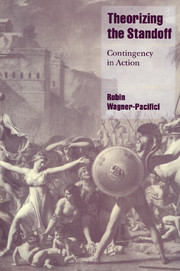Preface
Published online by Cambridge University Press: 22 September 2009
Summary
This book has had a double aim from the outset: to theorize contingency in social life and to analyze and extract the essence of real-life standoffs. By proposing the standoff as a privileged archetypal situation, the project has read contingency through the standoff and the standoff through its own contingency. Of course I am concerned with moments of danger and imminent violence for the damage they can do to lives and social systems. But I am also, and equally, concerned with ferreting out the “standoffish” aspects of everyday interactions and charting the various thresholds we all work hard to elude, thresholds that will take a conversation into the realm of the confrontation.
One of the striking aspects of researching responses to real-life standoffs is the discovery of the habitual connections made between situations and standardized categories. The books attempts to locate and theoretically press the idea of standard operating procedures as agents of the law and adversaries alike summon up their warrents, ultimatums, deadlines, electrical generators, fire engines, and so forth when an “emergency” has been declared. One category of standard agent, the “Hostage Rescue Team,” has particular theoretical resonance. As a specific group within the Federal Bureau of Investigation, this team is obviously trained to rescue hostages in situations of danger and potential violence. As will be explored, sometimes this team is sent into situations where there is no clear hostage (this was particularly true in the case of the Ruby Ridge, Idaho standoff of the Randall Weaver family).
- Type
- Chapter
- Information
- Theorizing the StandoffContingency in Action, pp. xi - xiiPublisher: Cambridge University PressPrint publication year: 2000

